Exploring the 7 Different Types of Data Stories
Exploring the 7 Different Types of Data Stories
What makes a story truly data-driven? For one, the numbers aren’t caged in a sidebar graph. Instead, the data helps drive the narrative.
Data can help narrate as many types of stories as there are angles. My colleague Ben Jones ofTableau Public inspired me to think of data stories as seven different types (à la Christopher Booker’s seven basic story plots). Jones based his idea on analysis of numerous data stories, and his framework helps imagine ways to free data from sidebar graphs. These categories are meant to be a thought-starter, not a final count, which is sure to be higher.
Let’s explore each category using data compiled by Freedom House, an independent watchdog organization. The data ranks each country as “free,” “partly free,” or “not free,” based on a score. Using this simple dataset, we can tell seven different stories. The angle depends on what you want the data to show and how you plan to show it.
1. NARRATE CHANGE OVER TIME
How many countries were categorized as “free” in 2013 versus in 2001? It turns out the number shrank over time. We can use the data to visualize the change, then explain the forces at work.
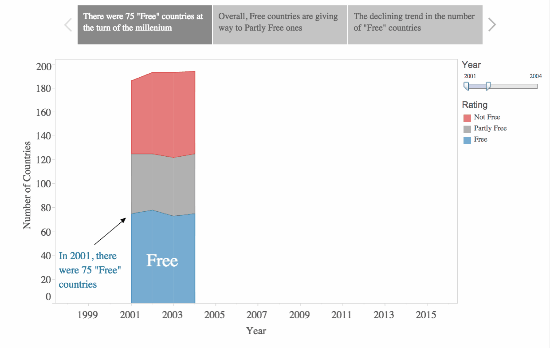
Credit: Ben Jones.
CNBC’s John Schoen took this approach to visualize the history of the Dow 30 over 87 years. The user can click on each decade and see how the index reacted to the tech boom, the inflation of the ‘70s, even the Great Depression. The CNBC staff paired the visualization with future forecastsbased on past trends.

The History of the Dow 30. John Schoen
Click to visit the full interactive visualization.
2. START BIG AND DRILL DOWN
Data can guide the reader from the big-picture view down to a focused view. Using the Freedom House data, start the reader with a world map of the scores, the big view. Then the reader can zoom in on a region — Asia, say — and see that more than half of the countries there are labeled as “not free.” Zoom in even more, and the reader sees that North Korea is the least free country of all.
We can guide the reader through this sequence by providing prompts in the copy as well as interactive filters.
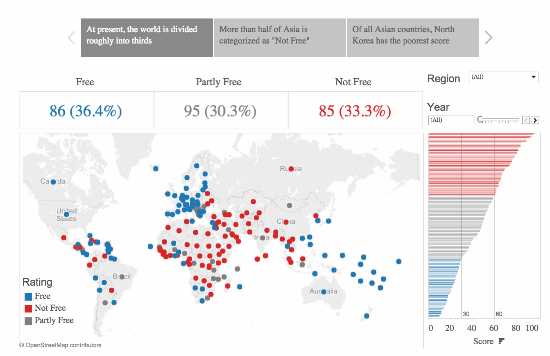
Credit: Ben Jones.
The example below shows vaccine-preventable outbreaks recorded around the world. The overview shows how many such cases exist. The filters allow the reader to drill down by country, disease, or year. The reader might be guided to see, for example, that whooping cough is more prevalent in the U.S. than elsewhere, and the story can outline the possible reasons why.

Vaccine-Preventable Outbreaks. Credit: CFR
Click to visit the full interactive visualization.
3. START SMALL AND ZOOM OUT
We can also do the reverse by starting with the molecular view and expanding to the larger view. For example, first focus on the three freest countries in the world, which happen to be clustered in Europe. From there, zoom out the narrative to show how other European countries stack up, then zoom out again to show the global comparison. Then the reader sees that just over one-third of all countries are labeled as “free.”

Credit: Ben Jones.
Here’s an example that looks at the impact of immigration on housing value. The reader can enter his or her zip code to start with a hyperlocal view. The interactive filter provides the statewide view, and the map overview gives the national perspective.

Immigrants and Housing. Credit: Jacob Vigdor
Click to visit the full interactive visualization.
4. HIGHLIGHT CONTRASTS
Outlining the differences in datasets can drive a powerful narrative. The 10 freest countries are all in Europe, and happen to be located close together. The 10 least free countries, on the other hand, are in five different regions.

Credit: Ben Jones.
Of course, geography is just one of the two groups’ many differences. Our story can explore the key ways in which the two groups differ, from government policies to culture to history. A study of contrasts could make for a captivating piece.
We can tell a similar story with the example below. It compares the gender gap in countries around the world based on three dimensions of human development: a long and healthy life, knowledge, and a decent standard of living. Countries on one end of the spectrum have large disparities while those on the other end have near-equality.

HDI Gender Gap. Credit: Ramon Martinez
Click to visit the full interactive visualization.
5. EXPLORE THE INTERSECTION
When two divergent lines of data intersect and one overtakes the other, questions result. The freedom data shows that the number of “partly free” countries overtake the “not free” countries, then go on to also surge past the “free” countries. What caused the shift? When standings change, people want to know the reason.
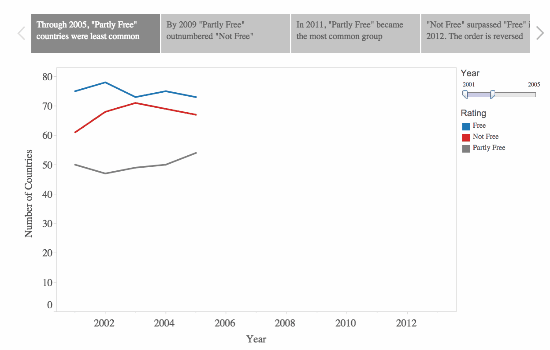
Credit: Ben Jones.
Sarah Ryley of New York Daily News visualized the number of summonses issued in New York since broken-windows policing took effect in 1993. The number rose sharply at first and held steady before starting a slow decline. Then a spike in stop-and-frisks led to an intersection with summonses in 2010. Granted, the two lines don’t compare apples to apples. However, the crossing and its components can drive a narrative about New York’s law enforcement strategy.

Summonses Since ‘Broken Windows.’ Credit: Sarah Ryley
Click to visit the full interactive visualizaton.
6. DISSECT THE FACTORS
Sometimes factors come together like pieces of a puzzle to form the big picture. The relationship might be additive or multiplicative. For example, each country’s freedom score is the sum of legal, economic and political freedom.
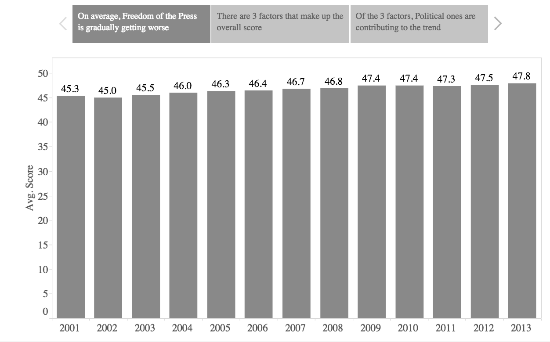
Credit: Ben Jones.
Here’s an example that shows how the sun controls the weather. The visualization draws the dot from sunspots to global weather, highlighting causal relationships along the way.

Sunspots. Credit: Matt Francis.
Click to visit the full interactive visualization.
7. PROFILE THE OUTLIERS
We are fascinated by things that aren’t like the others. We want to know the why and the how behind the outliers.
Finding the outliers sometimes takes a bit of data exploration. Visualize the freedom data as a scatterplot, and you might say there is no outlier. But break it down by regions in a box plot, and you start to see those that stand apart.
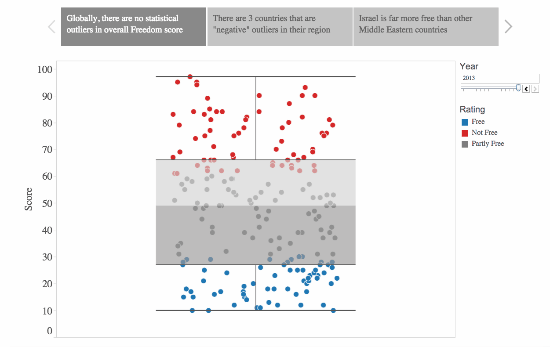
Credit: Ben Jones.
This example shows the number of government requests Facebook received in the first half of 2013. The map makes it clear that the U.S. is the clear outlier with a margin of more than 8,200 requests. An accompanying story could highlight the U.S. government’s stance on social media monitoring, main use cases, and possible reasons for the feds’ unusually high number of requests.

Facebook’s Government Requests. Credit: Andy Kriebel
Click to visit the full interactive visualization.
OTHER STORY TYPES?
We just explored the beginnings of seven different story types using one simple dataset. But as I mentioned, these categories are intended as a thought-starter. So what other types of stories should we add to this list? How else can we use data to tell stories? Share your ideas in the comments below.
Correction: This post has been updated to correct credits on the visualizations.
Martha Kang is the editorial manager of Tableau Software where she helps chronicle today’s big data revolution. A lifelong storyteller, she’s currently focused on telling data-driven stories that help us better understand our world, and ultimately, ourselves. Prior to joining Tableau, Martha worked as a journalist, first in TV news then in new media. She most recently served as the online managing editor of KPLU, an NPR affiliate in Seattle. There, she oversaw a number of projects, including the launch of Quirksee.org, a vertical site that featured two of her own award-winning stories, as well as a five-part, data-driven series, on Washington state’s idiosyncratic tax system.Martha has also worked at KOMO News, Northwest Cable News, and WLS-TV. In 2013, she was chosen as a Kiplinger fellow of public affairs journalism by Ohio State University.
转载于:https://www.cnblogs.com/yymn/p/4581605.html
Exploring the 7 Different Types of Data Stories相关推荐
- TYPES、DATA、TYPE、LIKE、CONSTANTS、STATICS、TABLES
TYPES.DATA.TYPE.LIKE. 42 创建数据类型与变量... 44 TYPES 语句... 44 DATA 语句... 46 CONSTANTS 语句... 48 STATICS 语句. ...
- Types of Data
企业中的数据都如何分类? 粗略的分类 如果粗略点的分类话,可以分为两类数据:主数据和事务型数据. 主数据(Master Data) "Master Data is your business ...
- Mysql Data types in summary.
MySQL Commands (Statements) • MySQL commands (also referred to as statements) fall into two ma ...
- java conversion_java 基本数据类型之间的转换(Conversion between Java basic data types).doc...
java 基本数据类型之间的转换(Conversion between Java basic data types) java 基本数据类型之间的转换(Conversion between Java ...
- Why Apache Spark is a Crossover Hit for Data Scientists [FWD]
Spark is a compelling multi-purpose platform for use cases that span investigative, as well as opera ...
- Technical User Stories – What, When, and How?
http://rgalen.com/agile-training-news/2013/11/10/technical-user-stories-what-when-and-how It happens ...
- Hi-C data analysis tools and papers
Hi-C data analysis tools and papers 全文链接如下: https://github.com/mdozmorov/HiC_tools Tools are sorted ...
- 课堂笔记——Data Mining(1)
一.Introduction -- 1.Major Issues in Data Mining User Interaction Presentation and visualization of d ...
- java basic data type,java基本数据类型--Basic Datatypes
Variables are nothing but reserved memory locations to store values. This means that when you create ...
最新文章
- Nucleus 实时操作系统中断(下)
- 响应对象Response
- 游戏开发中的向量数学
- 整人游戏-色盲在线测试
- html如何生成条形码,使用jsbarcode生成条形码
- 51单片机学习路程(一)
- 52单片机四种方法实现流水灯
- tweenMax下载和使用
- 简约卡通双十一营销策划PPT模版
- A0/A1/A2/A3/A4图纸大小分别是多少
- 容器化一个简单的 Mern stack app
- 日本留学签证 申请途径(通过中介)
- fbx sdk android,FBX SDK环境配置
- Spring @Autowired 用法
- 社区发现研究现状(一)
- 牛客--剑指offer,JZ3,JZ4,JZ5,JZ6
- 前后加编码_如何不加思考地编码?
- 双向链表增删改查C语言代码,C语言中双向链表的增删改查输出源文件代码
- c语言protect,PROTECT应该包含什么作业?
- 平台经济反垄断,未来三年开放式金融创新机会在何处?
热门文章
- python学生管理系统-Python 学生信息管理系统 2.0
- python 制作gif-利用Python如何制作好玩的GIF动图详解
- python快速自学方式-Python怎样自学?
- python爬虫百度百科-python爬虫(一)_爬虫原理和数据抓取
- python装饰器函数-【python3】 函数 装饰器
- python1000个常用代码-Python常用代码(1)
- python三层装饰器-python 3层装饰器及应用场景
- python飞机大战源代码-python版飞机大战代码分享
- python处理excel大数据-Python实现大数据收集至excel的思路详解
- jupyter安装插件,以及远程访问服务器上的jupyter notebook
